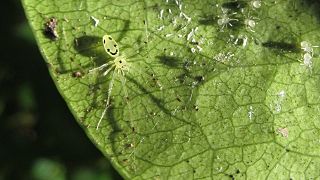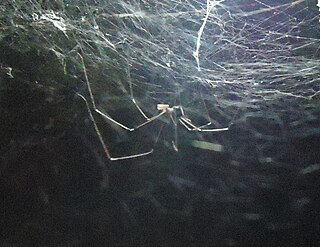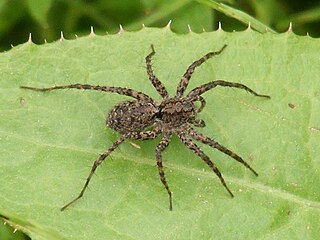
The Goliath birdeater belongs to the tarantula family Theraphosidae. Found in northern South America, it is the largest spider in the world by mass and body length, and second to the giant huntsman spider by leg span. It is also called the Goliath tarantula or Goliath bird-eating spider; the practice of calling theraphosids "bird-eating" derives from an early 18th-century copper engraving by Maria Sibylla Merian that shows one eating a hummingbird. Despite the spider's name, it rarely preys on birds.

Nephila is a genus of araneomorph spiders noted for the impressive webs they weave. Nephila consists of numerous species found in warmer regions around the world, although some species formerly included in the genus have been moved to Trichonephila. They are commonly called golden silk orb-weavers, golden orb-weavers, giant wood spiders, or banana spiders.

City of the Beasts is the first young adult novel by Chilean-American writer Isabel Allende. Published in 2002, the story is set in the Amazon rainforest. The novel was translated by Margaret Sayers Peden from Spanish to English. Walden Media acquired the novel's movie rights in 2006 but no film has yet been produced.

Steatoda nobilis is a spider in the genus Steatoda, known in the United Kingdom as the noble false widow, as it superficially resembles and is frequently mistaken for the black widow and other spiders in the genus Latrodectus. It is often referred to as thefalse widow, although "false widow" is a more general term applied to a wider group of species with this resemblance.[a] It is a moderately medically significant spider, with most bites resulting in symptoms similar to a bee or wasp sting. Some bites may cause more significant harm, partly due to pathogenic bacteria from the spiders.

Phidippus audax, the Bold jumper or Daring jumping spider, is a common species of spider belonging to the genus Phidippus, a group of jumping spiders easily identified by their large eyes and their iridescent chelicerae. Like all jumping spiders, they have excellent stereoscopic vision that aids them in stalking prey and facilitates visual communication with potential mates during courting. Bold jumping spiders are native to North America and have been introduced to Hawaii, Nicobar Islands, Azores, and the Netherlands. They are typically black with a distinct white triangle on their abdomen.

Theridion grallator, also known as the Hawaiian happy-face spider, is a spider in the family Theridiidae that resides on the Hawaiian Islands. T. grallator gets its vernacular name of "Hawaiian happy-face spider" from the unique patterns superimposed on its abdomen, specifically those that resemble a human smiling face. T. grallator is particularly notable because of its wide range of polymorphisms that may be studied to allow a better understanding of evolutionary mechanisms. In addition to the variety of color polymorphisms present, T. grallator demonstrates the interesting quality of diet-induced color change, in which its appearance temporarily changes as it metabolizes various food items.

Zygiella x-notata, sometimes known as the missing sector orb weaver or the silver-sided sector spider, is a spider species in the family Araneidae. They are solitary spiders, residing in daily spun orb webs. Z. x-notata is a member of the genus Zygiella, the orb-weaving spiders. The adult female is easily recognized by the characteristic leaf-like mark on her posterior opisthosoma, caudal to the yellow-brown cephalothorax.

Tambopata National Reserve is a Peruvian nature reserve located in the southeastern region of Madre de Dios. It was established on September 4, 2000, by decree of President Alberto Fujimori. The reserve protects several ecosystems of the tropical rainforest for the preservation of such forest and the sustainable use of forest resources by the peoples around the reserve.

Ballooning, sometimes called kiting, is a process by which spiders, and some other small invertebrates, move through the air by releasing one or more gossamer threads to catch the wind, causing them to become airborne at the mercy of air currents and electric fields. A 2018 study concluded that electric fields provide enough force to lift spiders in the air, and possibly elicit ballooning behavior. This is primarily used by spiderlings to disperse; however, larger individuals have been observed doing so as well. The spider climbs to a high point and takes a stance with its abdomen to the sky, releasing fine silk threads from its spinneret until it becomes aloft. Journeys achieved vary from a few metres to hundreds of kilometres. Even atmospheric samples collected from balloons at five kilometres altitude and ships mid-ocean have reported spider landings. Ballooning can be dangerous.

Amaurobius ferox, sometimes known as the black lace-weaver, is a common nocturnal spider belonging to the family Amaurobiidae and genus Amaurobius. Its genus includes three subsocial species, A. fenestralis, A. similis and A. ferox, all three of which have highly developed subsocial organizations.

Maevia inclemens or the dimorphic jumping spider is a relatively common and colorful jumping spider of North America. In the males there are two forms, a very rare phenomenon in zoology. These use different courting displays, and differ in appearance: the "tufted" morph has a black body and pedipalps ("palps"), three black tufts across its "head", and pale legs; and the "gray" morph has black and white stripes all over its body and legs, orange palps, and no tufts. However, each form accounts for 50% of the adult males, and they are equally successful in mating. A female of Maevia inclemens is 6.5 to 8.0 millimetres long, while males are 4.75 to 6.50 millimetres long.

Tarantulas comprise a group of large and often hairy spiders of the family Theraphosidae. As of December 2023, 1,100 species have been identified, with 166 genera. The term "tarantula" is usually used to describe members of the family Theraphosidae, although many other members of the same infraorder (Mygalomorphae) are commonly referred to as "tarantulas" or "false tarantulas". Some of the more common species have become popular in the exotic pet trade. Many New World species kept as pets have setae known as urticating hairs that can cause irritation to the skin, and in extreme cases, cause damage to the eyes.

The six-spotted fishing spider is an arachnid from the nursery web spider family Pisauridae. This species is from the genus Dolomedes, or the fishing spiders. Found in wetland habitats throughout North America, these spiders are usually seen scampering along the surface of ponds and other bodies of water. They are also referred to as dock spiders because they can sometimes be witnessed quickly vanishing through the cracks of boat docks. D. triton gets its scientific name from the Greek mythological god Triton, who is the messenger of the big sea and the son of Poseidon.

Spiders are air-breathing arthropods that have eight limbs, chelicerae with fangs generally able to inject venom, and spinnerets that extrude silk. They are the largest order of arachnids and rank seventh in total species diversity among all orders of organisms. Spiders are found worldwide on every continent except Antarctica, and have become established in nearly every land habitat. As of November 2023, 51,673 spider species in 136 families have been recorded by taxonomists. However, there has been debate among scientists about how families should be classified, with over 20 different classifications proposed since 1900.

Crossopriza lyoni is a widespread species of cellar spiders that prefer to live in or around human structures. They are commonly known as tailed cellar spiders, tailed daddy longlegs spiders, and sometimes box spiders. They all possess extremely long fragile legs that can reach up to 6 cm (2.4 in) long and a body length of that ranges from 2.5 to 7 mm. Their abdomens are distinctly squarish when viewed from the side and their carapace is more or less circular when viewed from above. They also possess two kinds of sound-producing organs and have six eyes.

Philip Anderson Lord and Christopher Robert Miller are American filmmakers. They are the creators and co-stars of the adult animated sitcom Clone High, and the writers and directors of the animated films Cloudy with a Chance of Meatballs (2009) and The Lego Movie (2014), as well as the directors of the live-action comedy film 21 Jump Street (2012) and its sequel, 22 Jump Street (2014).

Pisaurina mira, also known as the American nursery web spider, is a species of spider in the family Pisauridae. They are often mistaken for wolf spiders (Lycosidae) due to their physical resemblance. P. mira is distinguished by its unique eye arrangement of two rows.

Pardosa milvina, the shore spider, is a species in the wolf spider family. They are mainly found near rivers and in agricultural areas in eastern North America. P. milvina feed on a large variety of small insects and spiders. Ground beetles such as Scarites quadriceps and large wolf spiders such as Tigrosa helluo are predators of P. milvina. P. milvina are smaller spiders with thin, long legs. This species captures prey such as arthropods with their legs and then kills them with their venom. Their predators are larger wolf spiders and beetles. P. milvina are able to detect these predators from chemotactile and vibratory cues. These spiders lose limbs when escaping from predators and they can change their preferred location in order to avoid predators. P. milvina also use chemical cues in order to mate. During their mating ritual, the male raises his legs and shakes his body. Both males and females can use silk, a chemotactile cue, for sexual communication. Additionally, female shore spiders heavily invest in their offspring, keeping them in egg sacs and carrying them for a few weeks after they are born.
Schizocosa stridulans is a sibling species of S. ocreata and S. rovneri and is part of the wolf spider family. The name of the genus comes from the epigynum structure being lycosid and having a split T excavation. This spider is well-known for its specific leg ornamentation and courtship rituals and that is how it has been differentiated from its related species. The S. stridulans take systematic steps during its courtship ritual, which involves two independent signals. More specifically, female spiders will leave silk and pheromones to communicate that they are ready to mate.
Chiasmocleis royi, the reticulated humming frog, is a frog endemic to Bolivia, Brazil, and Peru. This frog often shares burrows with tarantulas in what may be a mutualistic or commensalistic symbiosis.


















